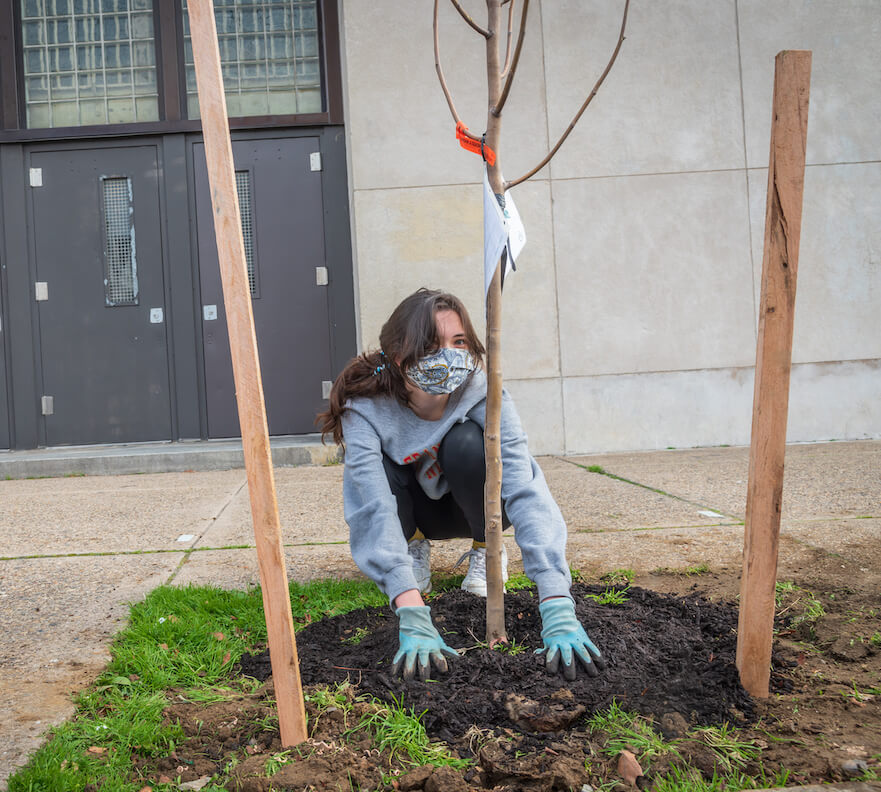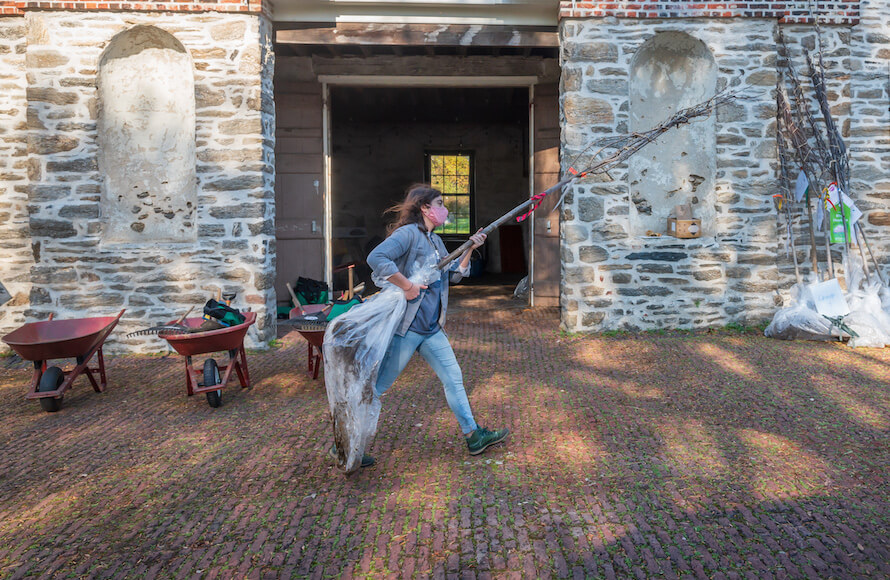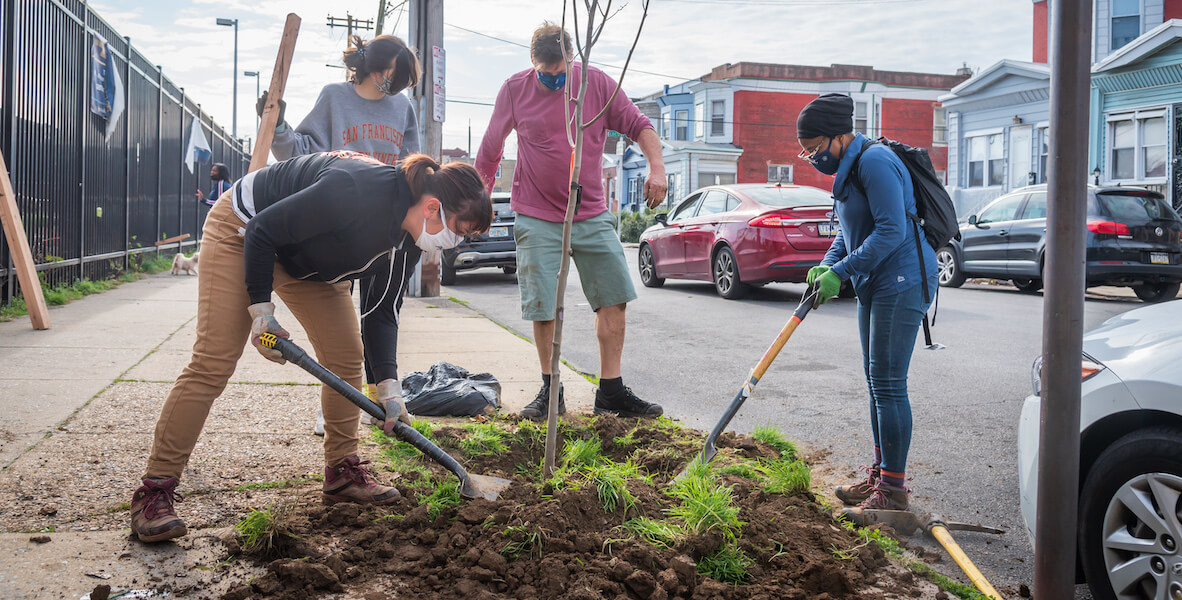Imagine, for a moment, it’s 2025 and you have a bird’s eye view of Philadelphia. As you scan the stadiums up to William Penn’s hat and beyond, you see a whole lot of verdant green amid the concrete—as much as 40 of the city’s 142 square miles.
These trees are purifying our air; storing tons of carbon dioxide; and reducing residential energy costs. Their masses of living roots absorb and hold water, reducing flooding, and their leaf canopy lessens the impact of rain drops on the ground, decreasing erosion. Their shade and transpiration magic is reducing temperatures by as much as 20 degrees. And they’re raising property values: Houses on streets with a lot of trees see a 10 percent boost in their sales price.
“Even in a built environment like Philadelphia, we’re all part of nature and we have that connection with trees, with plants,” says Ifill.
The City’s goal is to increase our tree canopy to 30 percent by 2025 as part of the Greenworks program. It hasn’t been going that well. According to The City of Philadelphia and University of Vermont Spatial Analysis Lab’s 2018 study, our tree canopy actually declined by six percent from 2008-2018. Our canopy is averaging about 20 percent, with some neighborhoods having as low as 2.5 percent coverage.
“The big problem is that, for the last several decades at least, we as a city have not been planting enough trees to make up for the trees that naturally die or are lost to development,” says Tim Ifill, Director of Trees at the Pennsylvania Horticultural Society.
Granted, the decline would be worse if not for the efforts of programs like Tree Philly, launched by the City in 2011 along with Greenworks to give free sidewalk and yard trees to building owners who would care for them, which has given away more than 20,000 trees. (Learn how to get one here.) And PHS, which has been fighting to catch up with canopy loss through their Tree Tenders program—training more than 5,000 volunteers who have collectively planted over 25,000 trees in their neighborhoods.

“Every neighborhood is different,” says Ifill. “Both from a canopy perspective but also for the types of people who get involved and how they decide to set up their tree tenders group.” In East Passyunk tenders worked with PHS to establish an urban arboretum, mapping about 40 different tree species—like Amelanchier grandiflora (princess Diana Serviceberry) and Ostrya virginiana (American Hope Hornbeam)—in the neighborhood. In Hunting Park, Esperanza partnered with PHS to host the first bilingual tree tender training—their group has been among the most dedicated tenders since, says Ifill.
If you’re tree tender curious, join the fall tree planting bonanza this week; from November 17th-21st, PHS Tree Tender groups and community orgs and volunteers will plant more than 1,350 trees (60 different species!) across the city. No prior tree-planting experience is required; volunteers will be led by at least one official Tree Tender who knows the ins and outs of this process well.
 Volunteers are still needed in Glenwood; West Poplar; Hunting Park; Grays Ferry and Point Breeze (check this map for more locations and details). These are some of Philly’s least green neighborhoods, according to conservation nonprofit American Forests’ recently released Tree Equity Score map. The Equity Score measures the gap between targeted tree canopy in a given block group—considering population density and climate as well as income level, employment rate, race, age distribution, health outcomes and heat island impact—and existing coverage.
Volunteers are still needed in Glenwood; West Poplar; Hunting Park; Grays Ferry and Point Breeze (check this map for more locations and details). These are some of Philly’s least green neighborhoods, according to conservation nonprofit American Forests’ recently released Tree Equity Score map. The Equity Score measures the gap between targeted tree canopy in a given block group—considering population density and climate as well as income level, employment rate, race, age distribution, health outcomes and heat island impact—and existing coverage.
Predictably, the highest scores in Philly are concentrated in wealthy neighborhoods; the map generally becomes less green as you move north, south and west. For example, Society Hill (15 percent people of color; 15 percent poverty rate) currently has 28 percent canopy coverage versus the targeted 32 percent, scoring 99. Crescentville (88 percent people of color; 76 percent poverty rate), in Northeast Philly has just six percent versus a targeted 48 percent, scoring 46. The average surface temperature is seven degrees warmer in Crescentville—73 degrees versus 80 degrees.
To get all block groups to a score of 75 or higher, we’d need to plant 198,923 trees here in Philly. Compare that to Washington DC, which only needs 28,121 more trees to achieve the same goal. And the city isn’t far from their targeted 40 percent canopy coverage by 2032.

Planting nearly 200,000 trees here in Philly would save an estimated 106,165 cubic meters of runoff; remove 14.6 tons of particulate matter pollution; and sequester 2, 707.4 tons of carbon every year. And they would reduce violence and increase mental health.
I mean, have you noticed? Walking down a tree-less Philadelphia street is like eating a soft pretzel without mustard. It feels barren; lacks a certain liveliness… just makes you feel less happy.
“Even in a built environment like Philadelphia, we’re all part of nature and we have that connection with trees, with plants,” says Ifill.
Join efforts this week to green, and in turn cool and heal, our neighborhoods. Show up with a mask and close-toed shoes and dress for the weather—all events will go on rain or shine. Register here (proof of vaccination is required).
The Citizen is one of 20 news organizations producing Broke in Philly, a collaborative reporting project on solutions to poverty and the city’s push towards economic mobility. Follow the project on Twitter @BrokeInPhilly.
![]()
Header photo courtesy of Pennsylvania Horticultural Society




